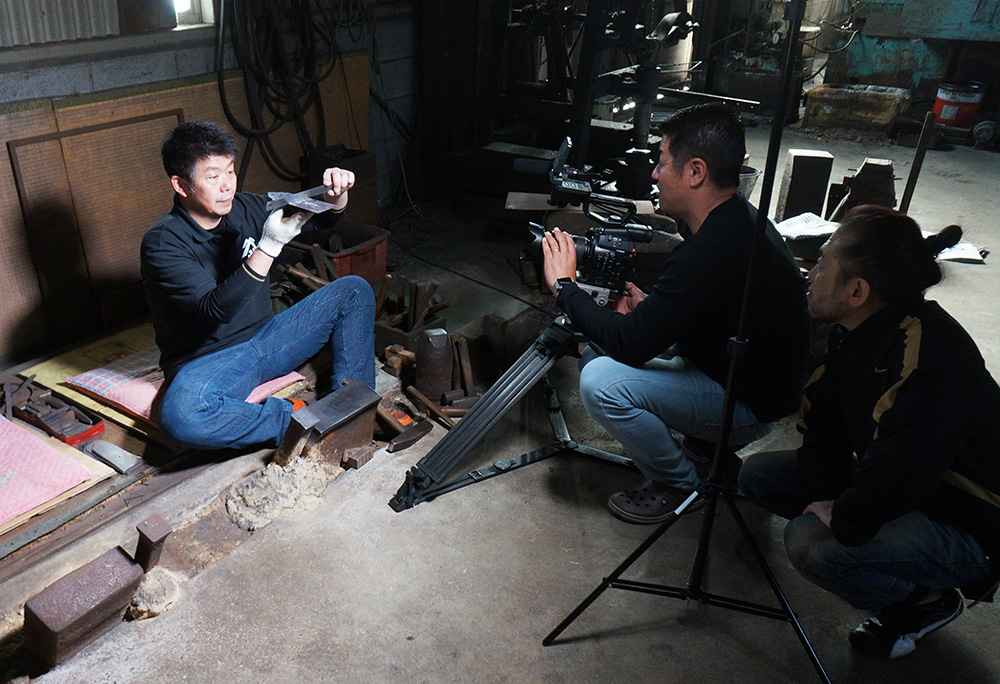Now that the episode of “Who Wants to Come to Japan?” (世界ニッポン行きたい人応援団) has aired, I can talk about my experience during the filming week. The first thing I want to share about is my visit to the Sugita family, a very generous family who run a top quality trowel business. Started by Sugita-san senior, the business (Sugita Kogyo) is a small operation and is now mostly handled by the son. During my two day visit, I had the privilege of observing Sugita-san’s process for making a hand-forged jigane trowel.
Plaster, trowel, and tool geeks — read on.
Hand-Forged Plaster Trowels with Sugita-san
Very few people in Japan still make trowels in the fashion described below. These trowels are beautifully made, and the labor involved is even more than I would have guessed. The end result is a top notch tool designed for applying traditional clay and lime plasters of all types. They’re especially good for base coats and they’re also used for a variety of finishes, too.
Most factory-made trowels are stamped out of steel and then fitted with a handle. Sugita-san makes a wide variety of trowels, but these forged jigane trowels are a specialty. Very few people still make them like this, so naturally they’re treasured by plasterers. Up above you can see a variety of his hammered jigane trowels, including a custom one made out of brass instead of iron.
Forging a Jigane Trowel, Step By Step
The above image shows all of the necessary steps to create a forged jigane trowel. The main steps are as follows:
- Cut iron to size and shape
- Fire and hammer iron
- Hammer iron flat
- Grind edges
- Punch and file hole for handle
- Fire iron and dip in oil
- Fit steel for handle
- Mount wooden handle
Because the iron is first fired and pounded (rather than simply stamped), there’s a lot of extra work in shaping the tool. All of that heat and pounding greatly distorts the iron.
However, the benefit of firing and hammering is that it increases the density of the iron. And because a thicker stock material is used, the tools are more substantial than stamped trowels, too.
There are some other subtle differences between these forged jigane trowels and a stamped steel trowel. The trowel is actually slightly curved across the width of the tool. This makes the metal quite rigid and strong, and there’s a slight “cupping” effect that happens when in use.
Sugita-san uses a few different hammers to flatten and shape the iron on an anvil, checking periodically with a straight edge to ensure that the shape and profile are correct. He’s looking for an even and subtle curve across the width. The tool should be dead flat across the length.
The result is that the final tool “holds” the plaster ever so slightly as it’s dragged across the wall surface. It’s such a subtle thing, but it makes a difference. The hammering process is time-intensive and requires a lot of careful work.
Once the hammering is complete, the rough edges are refined with a grinder and sander. If the edges are too sharp or thick, the tool will not perform well.
Sugita has a second forge exclusively for firing the finished tool. For the purposes of this jigane trowel, the iron is quickly fired once and dipped immediately in oil to give the final tool a beautiful black finish.
After all of the firing, shaping, grinding, etc., a hole is punched, filed, and fitted with a piece of bent steel for a wooden handle. Depending on the size of the plasterer’s hand, the neck can be adjusted to fit perfectly. 
Finally, a wooden handle is fitted to the metal and adjusted so that it’s perfectly square and straight. Even as an observer, I was really satisfied watching the handle fitting and knowing that the tool was nearly ready for use after all of that hard work.
I feel very grateful that Sugita-san gave me one of the two trowels he forged during those two days of filming. I will definitely treasure it and remember the time I spent with him and his family. They were all incredibly sweet and generous. It was a privilege to observe and ask questions, and share a delicious meal with the extended family. I hope I get to see them again someday…













É, as coisas de “antigamente” acabaram ou estão prestes de acabar.Como exemplo cito a profissão de ferreiro no mundo inteiramente extinta.Que pena.A profissão masculina de barbeiro também acabou em toda Polônia que visitei há dois anos. Sinal dos tempos.Parabéns pelo lindo e interessante artigo.
Por fim,só pela curiosidade:qual é preço de uma dessas ferramentas?